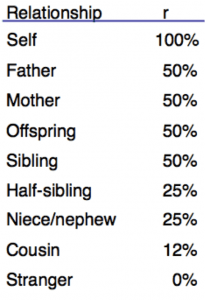Learning Objectives
- Define stimulus, behavior, altruism, individual fitness, inclusive fitness, sexual selection
- Interpret examples of how behaviors are encoded by genes and can evolve by natural selection
- Define and differentiate between proximate and ultimate drivers of behavior
- Explain how costs and benefits shape the evolution of a specific behavior
- Calculate and compare how individual and inclusive fitness between individuals of different relatedness promotes altruistic behavior
Heritable responses to stimuli are genetically encoded
Behaviors are defined as actions in response to stimuli (singular, stimulus, which is something that causes a response), and almost all organisms exhibit some form of behavior. Humans are naturally biased to recognize behavior of animals, but plants and even single-celled organisms react to their environmental surroundings. For instance, some bacteria emit small chemical signals into their environment, responding to environmental stimuli. When bacteria sense a critical mass, or quorum, of those signals, they change their own behavior, perhaps by releasing a toxin or by swimming away. This process, called quorum sensing, is how the bacterial species Vibrio cholerae causes the diarrheal disease cholera. In the slime mold genus Dictyostelium, individuals live as single cells until conditions become adverse. Under the adverse environmental condition of low food availability, Dictyostelium swarm together into a multicellular fruiting body, where only a few individuals will survive to reproduce. Plants also respond to stimuli by growing or turning toward the light, growing away from the pull of gravity, and some plants even respond to touch. And, of course, animals behave.
All behaviors are encoded by genes at some level and are therefore subject to evolutionary processes like genetic drift and natural selection. As a result, we can consider for every behavior how the action occurs (proximate cause) and why the action occurs (ultimate cause). Here’s an example from Tinbergen (1951): Three-spined sticklebacks are small, spiny fresh or salt-water fish that have elaborate mating behaviors which include nest building and defense. Male sticklebacks in mating season have bright red bellies that are attractive to female mates. Males build nests in the rocky or sandy substrate near shore and then protect the nest from other red things, on the assumption that red things are males hoping to eat their eggs. Experiments have shown that males do not react to the presence of other sticklebacks, or stickleback-shaped things, that are not red. Instead, they react exclusively to color, attacking any shape that is red (Tinbergen 1951). So, the proximate cause (the how) of the stickleback attack behavior is a red visual cue. The ultimate cause (the why) of the behavior is to protect their offspring, which will increase their reproduction, which with survival are a key components of evolutionary fitness that we learned about in the evolution module. Here’s a short video re-enactment of Tinbergen’s experiments, just for fun (the video is silent for the first few frames).
Think back to the Dictyostelium and Vibrio examples from above. What are the proximate and ultimate behaviors in those two examples?
Cost versus Benefit: When is a trait favored evolutionarily?
So, behaviors are encoded by genes, which makes behaviors subject to selection. When an organism behaves in a way that is costly, we would predict that natural selection should act to remove those organisms from the population, because their costly behavior would likely make them less biologically fit. However, some behaviors are costly in one way but beneficial in another way. Males of many species have exaggerated physical traits like long and showy tails that might slow down escape from a predator, but which also have an unexpected advantage in attracting mates. If females choose to mate with the males that have longer tails, or brighter colouration, or larger horns, or another seemingly costly trait, then those males have more offspring (higher fitness) than males with shorter tails, duller colors, or smaller horns. So, the cost according to natural selection is outweighed by the benefit of sexual selection. Formally, we can define sexual selection as selection that favors traits that increase the ability to find mates; sexual selection acts more strongly on one sex, typically males.
Cost-benefit analysis can also help us understand how behaviors that don’t seem immediately advantageous to the individual can be sustained over time in a population. How, for instance, can we explain the behaviors of the individual Dictyostelium who becomes one of the non-reproductive cells in the fruiting body? Or what about a yellow jacket worker, who spends her adult life helping the colony queen reproduce, but does not have the opportunity to have her own offspring? Altruism is a behavior that benefits another (the beneficiary) at a cost to the focal individuals (the altruist). These seemingly altruistic acts of being in a fruiting body or a non-reproductive colony worker can be explained evolutionarily using a cost-benefit formula that includes a surprising element—the relatedness between the altruist and the recipient of the altruistic act.
Say that you have a clan of meerkats, social mongooses from southern Africa. Some clan members act as lookouts, giving a warning call when a predator is sighted. Calling is a risky behavior that can get a young meerkat killed, yet meerkats will still call, protecting the clan. Imagine that a young male meerkat (focal) is brother to the alpha male in the clan. The focal meerkat is killed by a predator after giving an alarm cry that saves the other clan members, including the focal meerkat’s brother and his 6 babies. The focal male has an individual fitness of 0 offspring, making him appear to be very unfit. However, by relatedness he shares 50% of his genes with his brother, who had 6 offspring. By inclusive fitness, the focal meerkat has the equivalent of 3 offspring through his relatedness to his reproductively-successful brother. Mathematically, inclusive fitness = (individual fitness) + (relatedness) x (fitness of relative). So in reality, the focal meerkat’s fitness is well above 0, and it was an adaptive behavior for him to call because it enabled the survival of his close relatives. The table below shows common relatednesses in percentages of similar alleles, on average:
Hamilton (1963) showed that altruism can occur via natural selection if r B > C (called Hamilton’s Rule), where
- r is the fraction of shared genes between altruist and recipient (coefficient of relatedness)
- B is the average number extra offspring beneficiary produces (benefit)
- C is how many fewer offspring altruist produces (cost)
From the information given in the meerkat example above, what’s the inclusive fitness of the focal meerkat’s brother (the alpha male)?”
Hank Green summarizes these ideas well in his Crash Course video on Animal Behavior:
UN Sustainable Development Goal

SDG 13: Climate Action – Understanding the evolution of behavior and life history strategies is essential for predicting and mitigating the impacts of climate change on biodiversity. By understanding the factors that influence sociality, reproductive success, and reproductive timing, we can better predict how quickly and to what degree populations may respond to changing environmental conditions.



Pingback: Behavioral Ecology | BIO 111 Organisms to Ecosystems